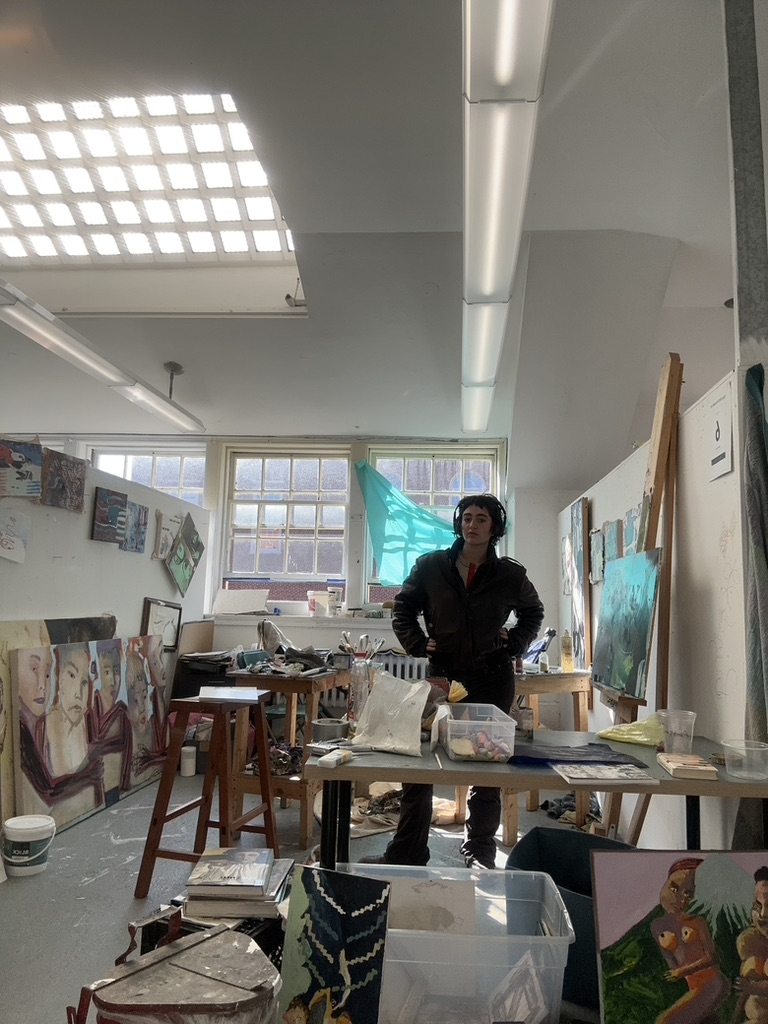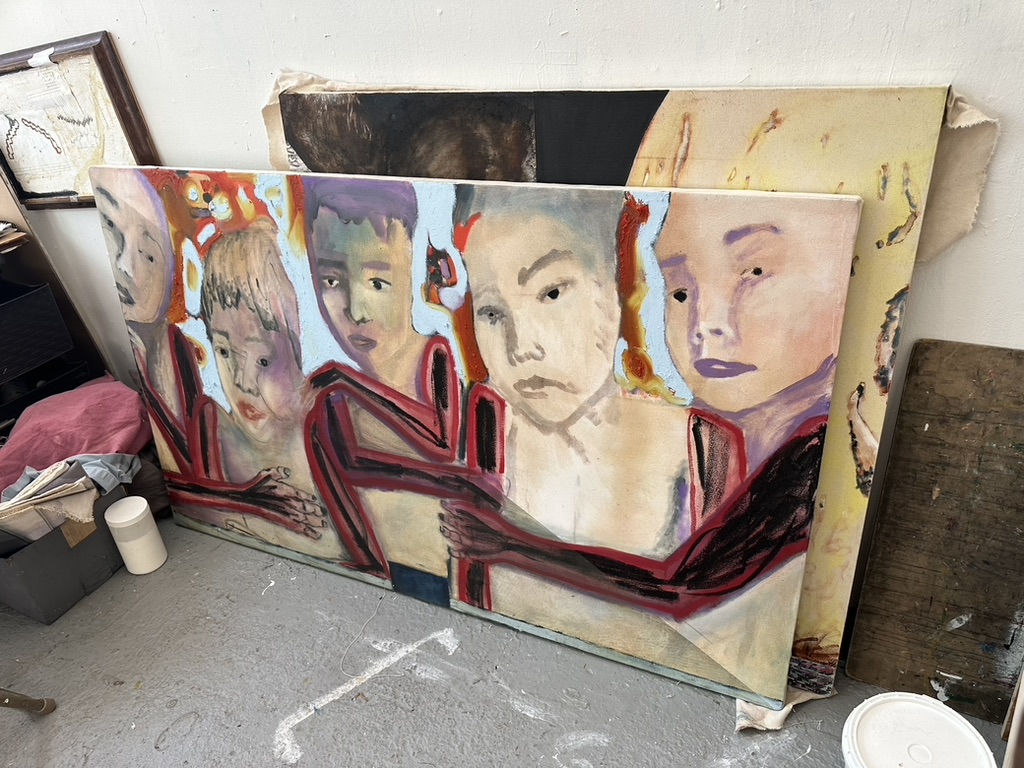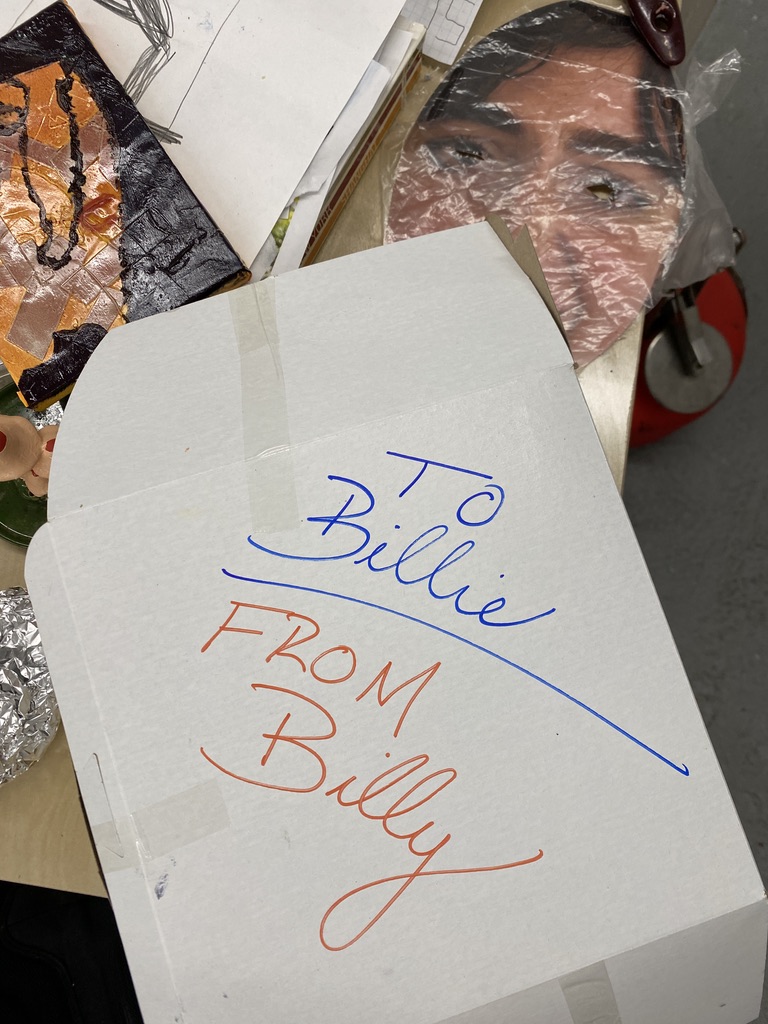Starchive: David LeGrand Visits Billie Wynn
Billie Wynn
→BFA PT 2025
David LeGrand
→MFA PT 2025
Tuesday, November 5, 2024, 4:20 PM
I knocked on the second door on the left on the sixth floor of the College Building, which opened directly into Billie’s studio. The space was divided into multiple sections to accommodate other artists, but Billie’s area stood out. Works in progress were scattered throughout, with materials—paint, canvas, torn paper, books, fabric swatches—strewn across the floor, creating an atmosphere of dynamic creativity. A beaming light poured in from a window, illuminating the room.
DL Billie, can you tell me about your studio practice and the kinds of ideas you’ve been exploring?
BW I think I’ve mostly been reflecting on where I’m at personally in my creative endeavors. I don’t want to have to write about every aspect of what I do—like putting a formal statement on everything. For me, it’s about feeling things out in the moment. When I come to the studio, I want to connect with the work confidently, but also let it evolve without overthinking all my choices.
DL I noticed that you are playing with what I see as characters—I am interested in how you look at the body in your work. What drives the choices you make in your depiction?
“I capture these people’s weirdness and subtleties in my work, creating stories around them without wanting to do so. When I look at people as references is the fact that they look like colors or shapes to me.”
BW I am drawn to many random references, like faces I’ve seen in the streets, even my friends’ faces. I just find them interesting—little moments between two strangers. I capture these people’s weirdness and subtleties in my work, creating stories around them without wanting to do so. One thing that I keep in mind when I look at people as references is the fact that they look like colors or shapes to me. I guess I am interested in how all the layers—shadows, colors, textures—come together to form something that feels real or surreal.
DL Speaking about layering, do you think of it as an investigation? Are you trying to capture something specific or just let things come about?
 Billie surrounded by works in progress and the energy of a thriving studio space.
Billie surrounded by works in progress and the energy of a thriving studio space.
BW Exactly. I am investigating things. It’s almost like creating an illusion of reality. Sometimes, I’ll place a hand or face where it “should” be, but other times I’ll distort it to see how far I can push that sense of reality. I want to see what happens when it is not so literal, almost like making people question what they see.
DL You talk about physicality in your work. What is your approach to the materials? Do you approach techniques in a similarly experimental way?
BW Definitely. Sometimes, I try out different techniques that fail, and I just end up wiping everything off and starting over. There’s a lot of trial and error involved, especially in how everything behaves.
DL Does that physical, almost unpredictable approach come into your photography practice too? Or do you keep that separate?
BW It is similar. I am not strictly a photographer, but when I do take photos, I like capturing those unplanned moments. I think that is part of what draws me to it. Photography can make people feel exposed or confront ideas about themselves they might not always acknowledge. I’ll edit photos to be weird, like overexposed—it is a different way of getting at that raw, unfiltered side of things.
 One figurative painting covering another, leaning against the wall of the studio.
One figurative painting covering another, leaning against the wall of the studio.
DL Collaboration seems important to you. Can you talk about how it fits in your work?
BW For a while, I did a whole semester on collaboration where I invited friends to join in or meet new people. Having that exchange is great; someone brings their own style or experience, which shifts my process. Sometimes, I consider using found materials as collaborations. Other times, it is the feedback I receive during my critique—I also consider that a form of collaboration. Collaboration lets me take a step back a bit and see what happens when others add to the work. I can feel less pressure on me and it’s more like a shared experience.
 “To Billie from Billy,” a snack box in the studio.
“To Billie from Billy,” a snack box in the studio.DL What does it mean to you to find your voice in your work?
BW It is tricky, as I am still experimenting with materials in my work, and I do not have a particular theme, so I am still finding it. I do not have a specific “voice” that I am consciously aiming for; it is more like a process of exploration. I try not to overthink it, just letting things unfold. I think people bring their interpretations to my work, so it is less about me dictating meaning and more about letting viewers come to their conclusions.
DL Thank you for this insight. You have given me lots to think about.
Billie Wynn wants to see you naked.